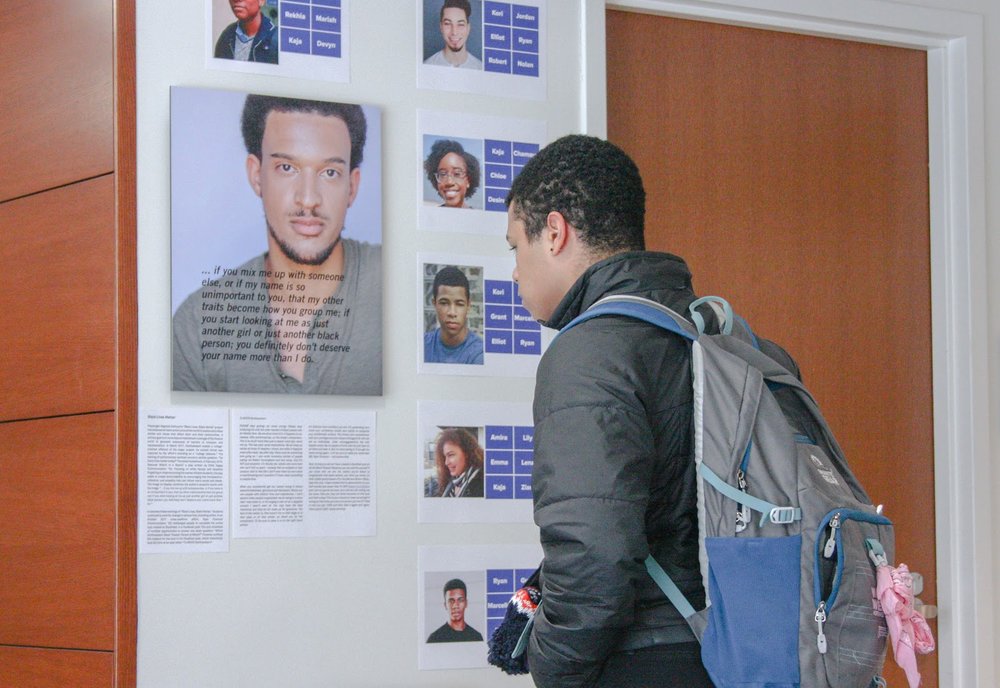Fifty years ago, Northwestern students peacefully occupied the Bursar’s Office to protest the black student experience. A month ago, hundreds of Northwestern students participated in a national walkout to support Parkland shooting victims and advocate for gun reform. Protest is an integral part of Northwestern history, and student activism lies deep in Wildcat tradition.
 On Monday night, Residential Services, University Archives, and the faculty and staff leaders of the South Area teamed up to transform the top floor of Shepard Hall’s Engagement Center into an inspirational gallery of campus activism. After a successful pilot exhibit about student life in early November, this new gallery of images was created to commemorate the events of ’68 and showcase the 50 years of student activism that followed. The walls were decorated with images ranging from large canvases of black-and-white photos to prints of Facebook posts and tweets, illustrating the similarities and differences between modern protests and those of the past. To set the mood, generations of protest anthems from Creedence Clearwater Revival’s “Fortunate Son” to Public Enemy’s “Fight the Power” played in the background.
On Monday night, Residential Services, University Archives, and the faculty and staff leaders of the South Area teamed up to transform the top floor of Shepard Hall’s Engagement Center into an inspirational gallery of campus activism. After a successful pilot exhibit about student life in early November, this new gallery of images was created to commemorate the events of ’68 and showcase the 50 years of student activism that followed. The walls were decorated with images ranging from large canvases of black-and-white photos to prints of Facebook posts and tweets, illustrating the similarities and differences between modern protests and those of the past. To set the mood, generations of protest anthems from Creedence Clearwater Revival’s “Fortunate Son” to Public Enemy’s “Fight the Power” played in the background.
While the gallery displayed images of Vietnam War demonstrations, the hunger strike for the creation of Asian-American Studies, and more, Charla Wilson, the Archivist for the Black Experience for Northwestern Libraries, said, “The goal of the exhibit was really to recognize and remember the 50th anniversary of the Bursar’s Office Takeover.”
 “Recognizing the [Bursar’s Office Takeover] as the first big student activist event is important [because] it inspired future events in giving voice to students,” said Nina Sedeno, a Weinberg senior who is “personally invested in student activism” and was moved to take notes of the gallery in her private journal. “These events happened through years of struggle and it is important to remember this often overlooked history, especially when speaking of Northwestern tradition.”
“Recognizing the [Bursar’s Office Takeover] as the first big student activist event is important [because] it inspired future events in giving voice to students,” said Nina Sedeno, a Weinberg senior who is “personally invested in student activism” and was moved to take notes of the gallery in her private journal. “These events happened through years of struggle and it is important to remember this often overlooked history, especially when speaking of Northwestern tradition.”
Before the existence of the Black House and the Multicultural Center, there were students, like us, who demanded to be heard and fought for change. Rachel Stamler-Jonas, a senior in the School of Communication, was intrigued by how “unusual” it is to see such an exhibit in a residential space on Northwestern’s campus. “I think it’s important to celebrate all the work people before us have done in order to give us the privileges we have now as they also serve as an important example for the kind of work that we need to continue doing,” Stamler-Jonas said.
 “As students in the university, we have a right to pressure the administration to meet our needs,” explained Sedeno. Nolan Robinson, a first-year student in the School of Communication, came to support his close friend and creator of the online quiz on the names of the Black students in the Theatre Department. Robinson was energized after seeing the concrete effects of the Bursar’s Takeover and how “that one thing in history encouraged so many student voices to speak up.” In her remarks to the crowd of over 70 attendees, Melissa Foster, the Faculty-in-Residence at Shepard Hall, stressed how even what might feel like “the smallest [of] things” can make a huge difference.
“As students in the university, we have a right to pressure the administration to meet our needs,” explained Sedeno. Nolan Robinson, a first-year student in the School of Communication, came to support his close friend and creator of the online quiz on the names of the Black students in the Theatre Department. Robinson was energized after seeing the concrete effects of the Bursar’s Takeover and how “that one thing in history encouraged so many student voices to speak up.” In her remarks to the crowd of over 70 attendees, Melissa Foster, the Faculty-in-Residence at Shepard Hall, stressed how even what might feel like “the smallest [of] things” can make a huge difference.
Most of the images and documents displayed in the exhibit (especially the older ones) came from the University Archives. Assistant University Archivist Janet Olson noted that the Archives relies on the participants and organizers of these activities to collect and donate the records so that future generations will have access to them.
After the reception ended and the room began to clear out, the images remained – and so, too, do the stories of past and current activists. These archives help us remember those who fought for what we have today. A clear message of the exhibit is to fight today for what we want those who come after us to have tomorrow. As Robinson emphasized, “Our voices are powerful and we shouldn’t be afraid to use them, because that’s why we have them – for them to be heard.”
